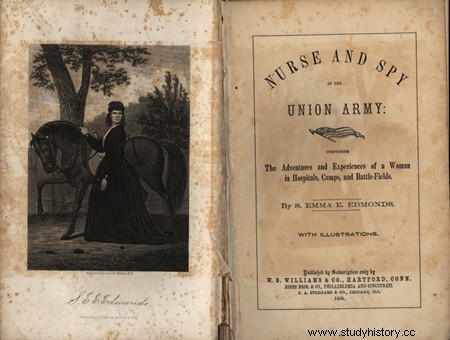Although women were not legally allowed to participate in the US Civil War, it is estimated that around 400 of them posed as men and fought. At this time, the role of women was limited to the domestic sphere and, in response to this role, recruitment was prohibited. Still, these 400 women decided to step up, pass themselves off as men - the only way to get there - and fight alongside the men. Taking on that role meant wearing men's clothing, preferably loose clothing, concealing her breasts, and cutting her hair. Logically, they had the complicity of the lack of rigor of the recruiting offices in times of war. And not only in relation to a physical examination, which would have quickly revealed their status as women, but also in relation to age, since seeing the faces or hearing the voices of some recruits it was clear that they were children and had lied to enlist. This is the story of one of those women, Sarah Edmonds .

Sarah Edmonds
Sarah Edmonds She was born in Canada in 1841, her childhood was difficult with a father who would have preferred a son to help him at work. The only pleasant memory of that time was the book «Fanny Campbell, the female pirate captain «, which narrated the adventures of Fanny Campbell, a pirate who was dressed as a man and who came to captain a ship. As a teenager she ran away from home and the ups and downs of her life took her to Michigan (USA). Shortly after, the Civil War broke out and Sarah, perhaps influenced by that book that she read so many times, enlisted in the Union Army... well, she enlisted Franklin Thompson . Since women could only do nursing work during the war and she wanted to fight, she cut her hair and dressed as a man; he was attached to the 2nd Michigan Infantry along with those who fought in various battles under the command of General George McClellan .
In December 1862, he volunteered to cross enemy lines and spy for the Union. His superior in charge of him told the general and he decided to give him a chance. He was provided with the necessary and he left for Yorktown, where he was working with the Confederates in the construction of fortifications. Three days later he returned with the information on said fortifications and the plans of the enemy. Due to his success, he was sent on several more missions, even posing as a woman – a role that, by the way, he embroidered. The following year, his regiment was sent to join the troops commanded by General Ulysses S. Grant , but Sarah/Franklin contracted malaria and fearing being found out if she was treated at the field hospital, she deserted and fled to Washington. She was admitted to a civilian hospital there and when she recovered she tried to return to the army but she could no longer… Franklin Thompson was wanted as a deserter . Faced with this new scenario, she decided to stay in Washington as a nurse until the end of the war.

«Nurse and spy in the Union army» (1865)
After the war, she married her childhood friend Linnus Seelye , with whom she had three children, and published the book « Nurse and spy in the Union army »(The Nurse and the Spy in the Union Army) in which she related personal experiences of hers, becoming a success and managing to sell more than 175,000 copies. Sarah's adventures began to arouse interest among public opinion and some even dared to request some kind of recognition for that woman. In 1886, twenty years later! , that recognition would come:the US government annulled her desertion charge and granted her a pension of 12 dollars / month for her services. In 1897, a year before she died, she became the only woman admitted to the Grand Army of the Republic , the Union Army Veterans Organization.
Sources:Civil War, Nurse anda spy in the Union army
